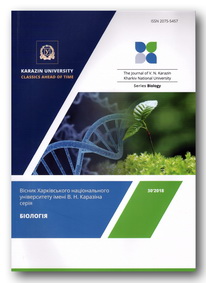Mites of the genus Erythraeus Latreille, 1806 (Acariformes: Actinedida: Erythraeidae) in the Greater Caucasus (within Azerbaijan)
Abstract
Mites of the family Erythraeidae Robineau-Desvoidy, 1828 are distributed worldwide and have been reported as natural enemies of sucking pests. Adults and deutonymphs are predators; larvae of most species are ectoparasites of different arthropods. They can be harmful to beekeeping. Some species cause dermatitis in humans. Erythraeidae of the Caucasus are poorly studied. This article is the first report on mites of the genus Erythraeus Latreille, 1806 of the family Erythraeidae living in Azerbaijan. An annotated list of five species of mites of this genus collected in the Greater Caucasus is provided: Erythraeus phalangoides (De Geer, 1778), E. regalis (C.L.Koch, 1837), E. gorcensis Gabrys, 2016, E. opilionoides (C.L.Koch, 1837), E. adpendiculatus (Schrank, 1781). All of them are recorded from Azerbaijan for the first time. An identification key to imago of the Erythraeus species is given. The original photographs of imago were taken to clarify the determination. Mites were collected in three landscape zones: semi-desert (4 species), mountain-steppe (2 species) and mountain-forest (2 species). The Absheron Peninsula (semi-desert) is studied best; four Erythraeus species were found there. Most of the species were collected in artificial forests with a predominance of Eldar pine (4 species, 12 individuals). In other biotopes, mites of the genus Erythraeus are rare: 2 species (3 individuals) were found in broad-leaved forests of the low mountains, 1 species (1 individual) in a forb steppe, 1 species (1 individual) in an arid open woodland consisted of weeping pear trees, 1 species (1 individual) in a garden. Only four individuals of E. regalis were recorded on plants. The other mites were collected under stones, which will make it possible to attribute them to herpetobionts, and E. regalis to herpeto-hortobionts. Out of 18 individuals found, 17 were adult, and one larva of E. regalis was removed from spittlebug on a blackberry. The most common Erythraeidae genus in the Greater Caucasus is Abrolophus Berlese, 1891 (39 individuals belonging to eight species were collected). This is the only genus of the family Erythraeidae, found in four landscape zones, from semi-desert to subalpine. The genus Erythraeus was not found in the subalpine zone.
Downloads
References
Aslanov O.Kh. (1997). Fauna and landscape-biotopic distributium of predatory Prostigmata mites (Acariformes: Trombidiformes) of Great Caucasus (in border of Azerbaijan). Baku. 146 p. [In Russian]
Aslanov O.Kh. (2008). To the study of predatory actinedid mites (Acariformes: Actinedida) of Azerbaijan Vineyards. Proceedings of the Azerbaijan society of Zoologists, 1, 210–216. [In Russian]
Aslanov O.Kh., Rubtsova L.Ye., Khanbekova Ye.M. (2015). Mites, associated with honeybees (Apis mellifera Caucasica Gorb.) in Azerbailan. Proceedings of the Azerbaijan society of Zoologists, 7(2), 119–126. [In Russian]
Vainstein B.A. (1960). Tetranychid mites of Kazakhstan (with revision of family). Alma-Ata: Kazakh State Publishing House, pp. 17–26. [In Russian]
Bartsch I., Davids K., Deichsel R. et al. (2006). Süsswasserfauna von Mitteleuropa / In: Chelicerata Araneae, Acari. Springer Spectrum. Vol.7, pp. 69–73.
Beron P. (2008). Acarorum Catalogus I Acariformes: Calyptostomatoidea (Calyptostomatidae), Erythraeoidea (Smarididae, Erythraeidae). Sofia: Pensoft and Nat. Mus. Natur. Hirst. 271 p.
Gabrys G. (2016). A key to postlarval Erythraeidae (Acari: Actinotrichida) of Poland. Rocznik museum gornoslaskiego w Bytomiu, 22, 1–22.
Gabrys G., Roland E. (2016). A redescription of Erythraeus acis (Berlese, 1882) Non Schweizer, 1951 (Acari: Actinotrichida: Erythraeidae) with notes on some related species from the Palaearctic Region. Annales Zoologici, 66(3), 417–430. https://doi.org/10.3161/00034541ANZ2016.66.3.008
Ido T., Kumakiri M., Lao L.M. et al. (2003). Dermatitis caused by Balaustium murorum. Acta Derm. Venereol., 84, 80–81.
Muñoz-Cárdenas K., Fuentes-Quintero L.S., Rueda-Ramirez D. et al. (2015). The Erythraeoidea (Trombidiformes: Prostigmata) as biological control agents, with special reference to the genus Balaustium / In: D.Carrillo, G.de Moraes, J.Peña (eds.) Prospects for biological control of plant feeding mites and other harmful organisms. Progress in Biological Control. Springer, Cham. Vol.19.
Southcott R.V. (1989). A larval mite (Acarina: Erythraeidae) parasitizing the European honey bee in Guatemala. Acarologia, 30(2), 123–129.
Stålstedt J. Wohltmann A., Bergsten J., Makol J. (2016). Towards resolving the double classification in Erythraeus (Actinotrichida: Erythraeidae): matching larvae with adults using 28S sequence data and experimental rearing. Org. Divers. and Evol., 16, 761–790. https://doi.org/10.1007/s13127-016-0283-5
Authors retain copyright of their work and grant the journal the right of its first publication under the terms of the Creative Commons Attribution License 4.0 International (CC BY 4.0), that allows others to share the work with an acknowledgement of the work's authorship.




